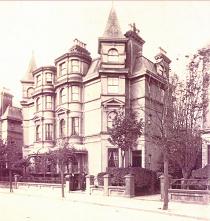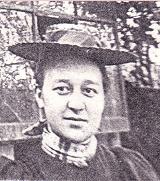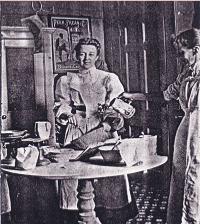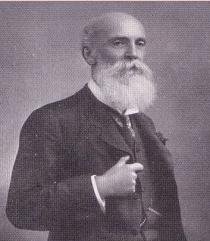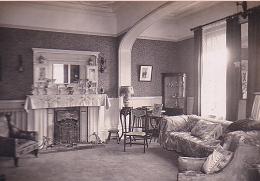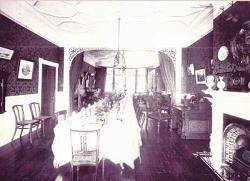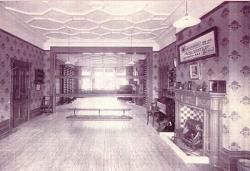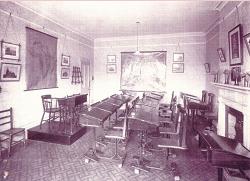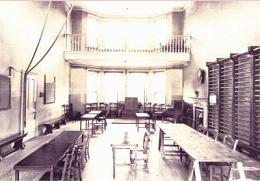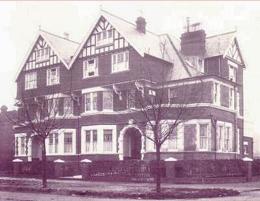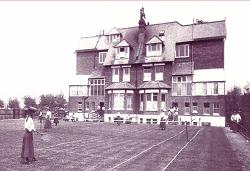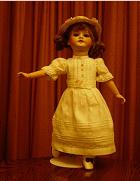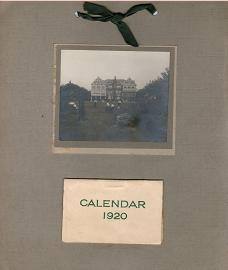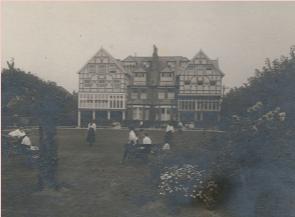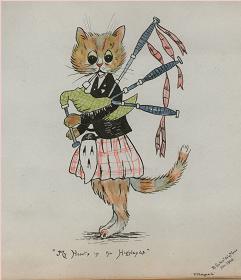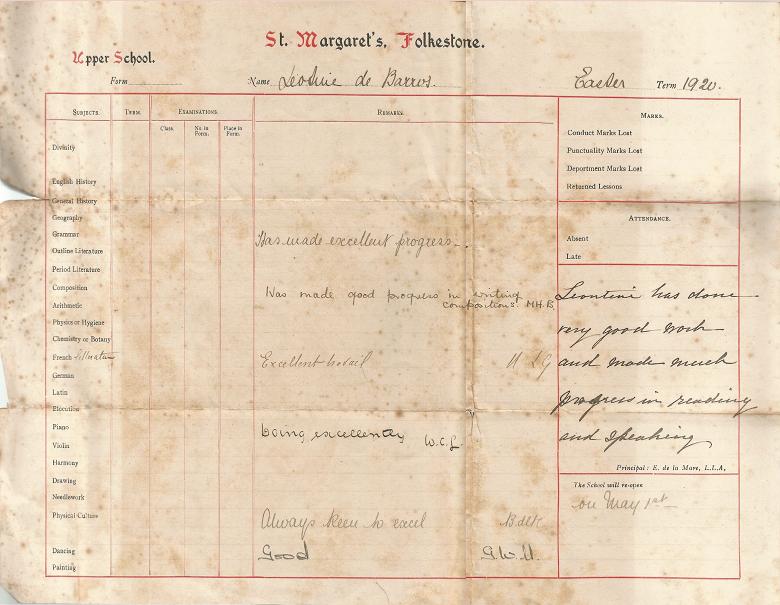Chapter 1
1890 - 1922
The aunt, Miss de la Mare
Miss Eliza de la Mare came from an old Channel Island family. Unlike her cousin, the poet Walter de la Mare, who pronounced 'Mare' as if it were a female horse, she retained the correct French pronunciation of 'mar'. At seventeen Miss de la Mare decided to become a teacher and, after completing her training, started her own school in Guernsey. When her mother died, she came to the mainland and took posts in schools at Saltaire, Donnington, Sale and Manchester. In 1883 she opened a school called Wellington College in Hastings. She moved to Folkestone in 1886 and became the first Head Mistress of Kent College, which she left in 1890 to found a new school. She wished to commemorate her mother's name, Margaret, and it was suggested that it would be appropriate to link the school to a saint, St Margaret of Antioch being the obvious choice. Thus was born St Margaret's School, Folkestone, advertised in the newspaper as "A High Class School for the Daughters of Gentlemen". Miss de la Mare was joined in this venture by her friend, Miss Murray, a clever young Scotswoman from Edinburgh whose first teaching post had been at a Lincoln school called The Priory. Miss Murray's chief interests were philosophy and the religions of the world. In addition to being Vice Headmistress at St Margaret's, she taught English and edited the school magazine. She died on 23 December 1911.
16 CLIFTON CRESCENT
The first St Margaret's School building was near the Leas on the north side of Clifton Crescent near its western extremity. Today there are fewer trees and hedges, and another dormer window has appeared on the roof, but otherwise the external appearance of the building is unchanged.
The playing field adjoined the Leas at the other side of Earl's Avenue on the site of the present Manor House.
Alice Renford attended the school during the last years of Queen Victoria's reign, 1894-99, and wrote: "There was a garden, with a square beyond it, where the elder and less noisy girls were allowed to take the air. I remember Miss de la Mare saying that I could join them, as I was not "a screaming girl", and being very flattered. I did not get many compliments at school and that was one of them. We were so near the front that we could hear the band playing on summer nights, and used to stand up on our beds at 'God save the Queen' less from loyalty, I think, than from a desire to do something we ought not under cover of it."
Miss de la Mare's two elder nieces attended the school, also with the surname de la Mare: Marguerite Bishop (born 1877), Bertha Guilbert (born 1881). There was a third niece, Kathleen.
Alice Renford recorded her memories of this remarkable lady: "Miss de la Mare used to go out in a very tall black bonnet (mauve or black on Sundays) and a cape with beads or something that tinkled as she went along with her quick swinging walk. Indoors she had a dark dress with a tight red front, buttoned all down the side. She used to stick a pencil between the buttons, and yet I never saw one come off. I am sure they would have if they had been on me. They say no-one has a nick-name who is not loved, and we called her 'Delly' among ourselves, and I am not ashamed to recall it. I know she knew and that she did not mind, for she said once, "You might give me my full name", but there was a twinkle in her eye as she said it. There was often hidden gaiety under her sternness. I can never think of her as 'Delly' without a smile. Miss de la Mare's mind was as straight as her back, and she kept them so, I hear, to the last. "Girls, hold yourselves up! I obtained my first post by the straightness of my back," she often said, and I can well believe it. It was a back to inspire confidence indeed. She had no use for slouchers and slackers, but she was always kindness and gentleness itself to the really delicate and tired. I think she had one great 'fault' - she loved us all too much. I am not sure that we were worthy of it: some perhaps, but not all. She was like the mother of a large and varied family, but I often thought there was something in her of a queen. Her regal carriage, her tone of authority, her fearlessness, reminded me of one. How terrible those dark eyes could look when angry. I can see her now, her fine head with its crown of iron-grey plaits thrown back, her sensitive mouth tight."
In her role as chaperone, Miss de la Mare would follow in a carriage when her girls rode with the riding master along Cherry Garden Avenue, which at that time was a lovely country road.
Miss de la Mare had a beautiful French doll which was made in 1898. It is now in South Africa, having been in the care of my late sister Amber Ogden (née Thomas) to whom it was given in 1946 by the niece, Miss Guilbert de la Mare. The doll has been renovated and looks exquisite.
BOUVERIE ROAD WEST
After ten years in Clifton Crescent the school, with forty girls, had outgrown its first home and in 1900 moved to a detached house, since demolished, on the corner of Bouverie Road West and Trinity Road. This was Sandroyd Lodge, belonging to Mr Ralph who lived next door and owned the Leas Pavilion. The school was there for three years. In 1903 the Board of Education gave the school official recognition: an encouraging reward and a spur to the next phase of development.
35-37 EARL'S AVENUE
In 1903 Miss de la Mare bought a pair of semi-detached houses 35-37 Earl's Avenue and immediately set about converting them into one house suitable for the school. Connecting doors were created in the basement between the sewing room and the kitchen, and on the ground floor between the School Room and the dining room. 'The bridge' was built to make a connection upstairs and serve as a fire escape. By November the classrooms were ready for lessons, but Sandroyd Lodge still provided the dormitories and dining facilities until the final move was completed in December.
Violet Brabazon, daughter of the Earl of Meath, was at the school at this time. [She married Viscount Grimston and later became Countess of Verulam.] Violet organised a collection to buy a carved desk and chair for Miss de la Mare to mark the transfer to the new premises. With the presentation came an album autographed by the subscribers. At first the desk was sited in the dining room, but was later used in Miss de la Mare's study across the corridor.
The girls were impressed by the dining room "fifty-one feet long with its crimson and white walls and brilliant electric light" and the neighbouring room which was the original gymnasium, "the same size as the dining-room and divided into two when desired by a revolving shutter, lighted also by electric light and heated by two splendid stoves." The chief colour-scheme was blue and green, and everyone remarked on the attractive appearance of the large, light and airy rooms.
Improvements and additions were made from time to time. There was already one dormer attic window in the rear roof, and Miss de la Mare added three more, slightly smaller. A series of alterations were made to the glass-fronted rooms at the outer ends of the first floor facing the garden. First their roofs were raised to align with the rooms next to them. Later they were extended outwards towards the garden, supported by stone pillars, and two stories were built over them under gables that echoed those on the front of the house. There were insubstantial bridges leading from the back doors across the gap outside the basement rooms, and Miss de la Mare replaced these with solid bridges and brick parapets. The wooden fence along the northern edge of the garden was replaced by a brick wall.
1904
The Earl of Meath, who had two daughters at St Margaret's, had been urging schools all over the country to recognise Empire Day (24 May) by some display of patriotic loyalty. In 1904 St Margaret's was the first to respond and began a series of annual celebrations by erecting Union Jacks in front of the school building and a huge banner bearing the words 'God bless our Empire'. There were hymns and prayers for the Royal Family and Government of the Empire.
The School had by now established itself as one of the most admired and respected of its type, under the leadership of the remarkable Miss de la Mare. Her upright sense of discipline was spiced with an irrepressible humour, never forgotten by many of the girls in her care.
1907
Klara Seth Paul, mother of Maud van Hien, was at the school with her sister Sophie in 1907. She came directly into the senior school, where finger nails had to be shown to the mistress as the girls came downstairs. She recalled her first meal in the school, where a request for pepper had to be passed down the table from girl to girl. Klara whispered "Pepper, please!" to her neighbour, who chose to humiliate the newcomer by announcing in a loud voice: "This stranger wants her Papa!" Klara was amused to see that the closely seated girls were given numbers along the table, so that when mutton was to be cut up, the evens sat well back to give elbow space to the odds before changing over.
Klara recorded one of her misdemeanours: "For an April Fool's Day joke I rang the morning bell 20 minutes too early. The result was that most girls came down too late. Not so Miss de la Mare who, punctual as usual, came down when the bell rang, although her dress was still partly unhooked. Needless to say I had a good scolding afterwards in her study. I still remember myself standing there with downcast eyes studying the pattern of the carpet, and feeling myself the 'childish, foolish girl' she told me I was. But when in the end I looked up I saw to my surprise a humorous twinkle in the corner of her eye, and could not help exclaiming, 'But you are not really angry, Miss de la Mare!' Then she burst out laughing and said, 'No, I am not, but it was my duty to scold you all the same for causing so much disorder. Don't let it happen again. And now run along, my child!' As far as I can judge, she never minded an innocent naughty joke, as long as all was straightforward and there was nothing dishonourable in it."
After the Great War Klara was to become the author of a book in Dutch entitled Truus Rovaarts' kostschool-ervaringen' (boarding-school experiences) based on her own life at St Margaret's. Her nom de plume was Katé Espé, representing her name initials K.T.S.P. pronounced the Dutch way. Her daughter, Maud van Hien, showed me the cover of the book, but its contents are no longer available. Maud told me an extraordinary thing. She and her mother were in a Japanese prisoner-of-war camp on Java - this was related as casually as if she were talking about a guest house in Brighton - and as they were browsing through the camp library where former prisoners had left their books behind, they spotted Klara's book, with Truus on the front cover grasping a hockey stick, gym slip tassels fluttering in the breeze and white cliffs in the background.
1908
Many Old Girls visited the school and put their signatures in an album, and the Old Girls' Guild reunions were held annually in London from 1908, at first as a dinner at the Charing Cross Hotel, then a tea party, and later held in St James's Street at the Royal Over-Seas League.
THE NIECES
Meanwhile Miss de la Mare's three nieces were equipping themselves for their future roles.
At 18 Marguerite Bishop attended an international finishing school in Geneva. It was called 'Les Marguerites'; perhaps the family chose it for its name. It seems she also did some teaching there, because her album of poetic contributions from friends and relatives include several apparently by pupils addressing their teacher. She went on to teach in France and Italy.
Bertha Guilbert trained at Dartford College of Physical Education, earning a diploma in the Swedish Drill system of Bergman Osterberg. She taught physical culture at Bridport before returning to St Margaret's to take up an appointment as qualified Calisthenics and Games Mistress as well as general assistant to her aunt. Although people on first-name terms called her Bertha, she was known in the school as Miss Guilbert, which was her mother's maiden name as well as her own second Christian name, pronounced Gilbert. Outside the school she, like her aunt and sisters, was addressed as Miss de la Mare.
Kathleen read Geography at Somerville College, Oxford, and earned a BA Hons and a diploma. She then taught in several private and state secondary schools.
The School Room adjoining the dining room was used by Miss Guilbert for gym. During these classes Miss Guilbert would play the harmonium which stood next to the fire place, for music was an important feature in the Swedish Drill system. She would play marches, polkas and mazurkas while closely watching the girls as they exercised. Miss Guilbert also played this harmonium for hymns during assembly.
This class room was on the first floor above the School Room, facing Earl's Avenue. Each girl sat at one of Dr M Roth's 'Modern Adjustable Desks' with their incorporated chairs and curious foot pedals. These desks received many engraved initials and names throughout their career, and half a century later on a parents' open day my mother was delighted to find one with 'Ruby Gordon' carved into it. There were only a few left by the sixties, and those able to get to them first on the day term opened were envied by the rest who had to be satisfied with horizontal desk tops and ordinary chairs.
THE LODGE, 14 GRIMSTON GARDENS
A detached house adjoining the end of the garden was acquired in 1907. The floor separating the main part of the ground floor from the rooms above was knocked out so that a huge gymnasium could be built to Miss Guilbert's specification with very high ropes and the set of five ribstalls previously sited in the School Room. Remains of the upper floor were left at each end, forming a pair of mezzanine balconies for spectators. The Lodge was formally opened on 17 and 19 July in a ceremony including displays of gymnastics. It had to be done twice because there was not enough space to accommodate all those who wanted to attend. The gym doubled as a kindergarten during the mornings. The very young children went home for the afternoon and the older ones had lessons in the main building, vacating the room for Miss Guilbert's gym classes.


